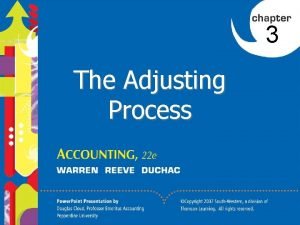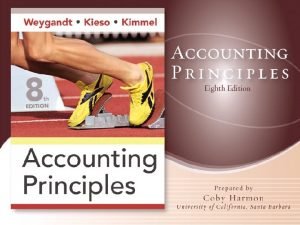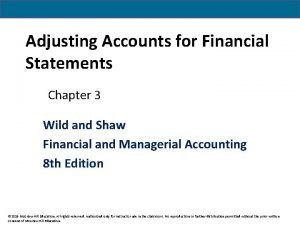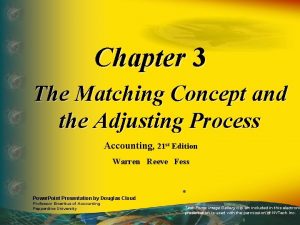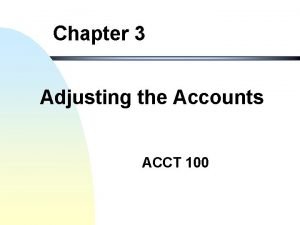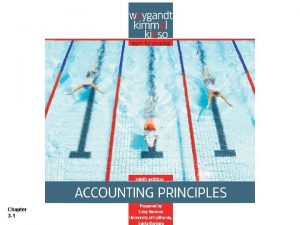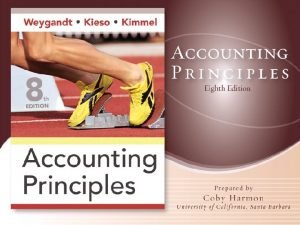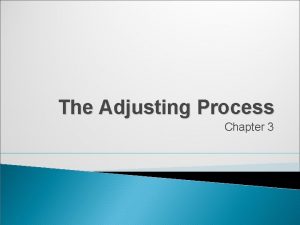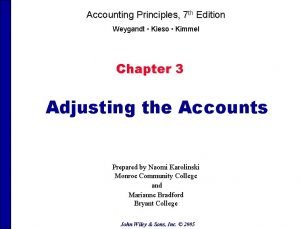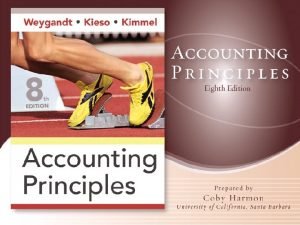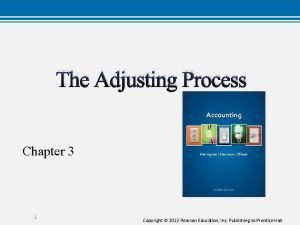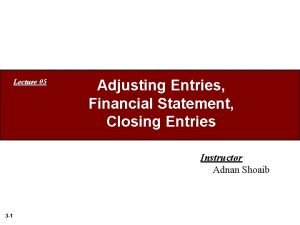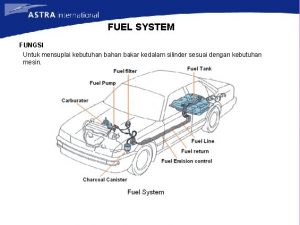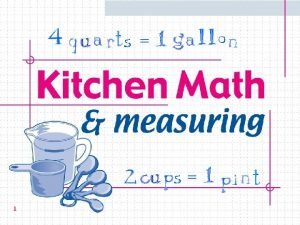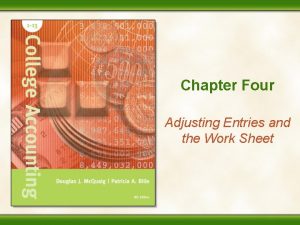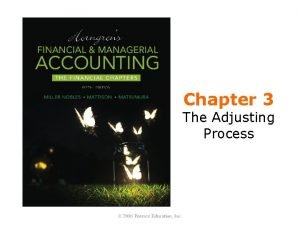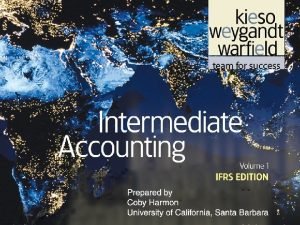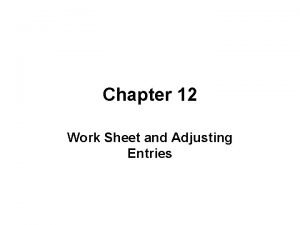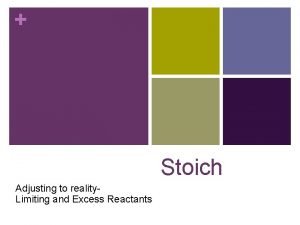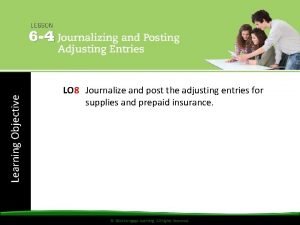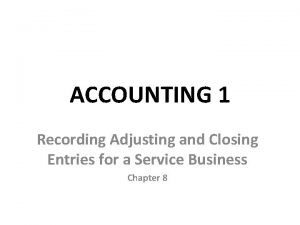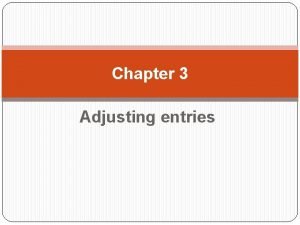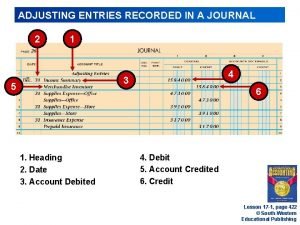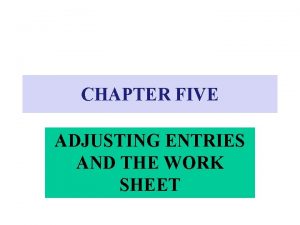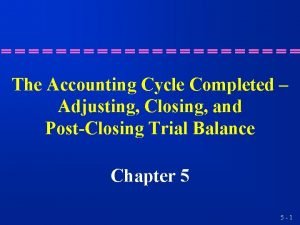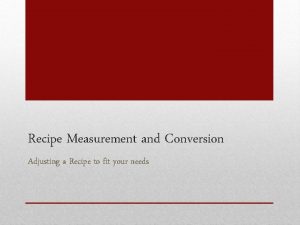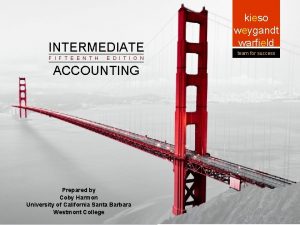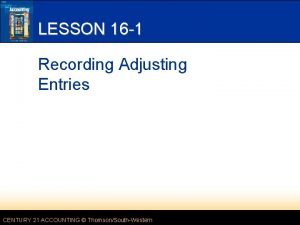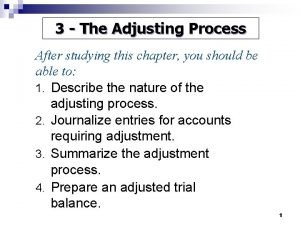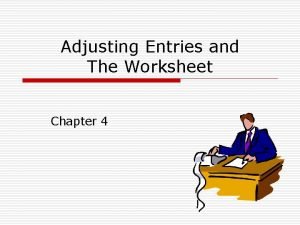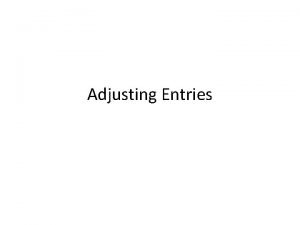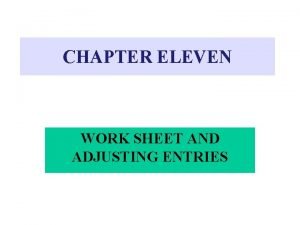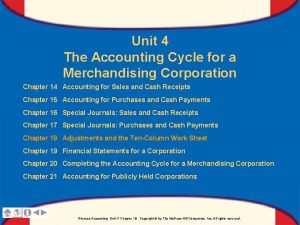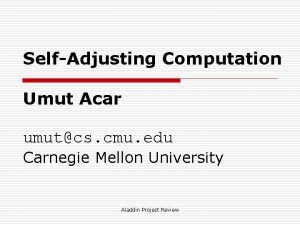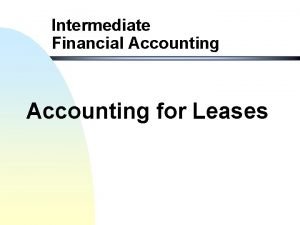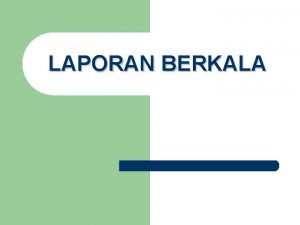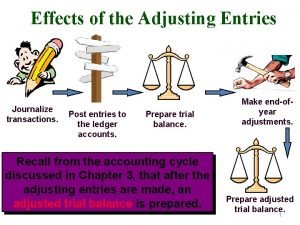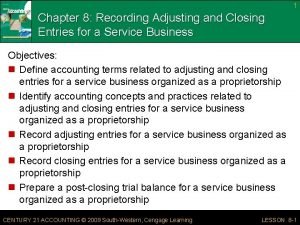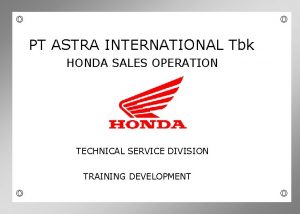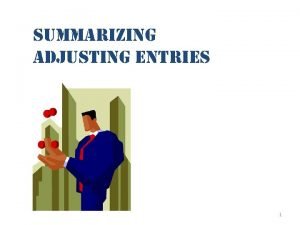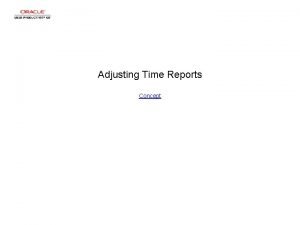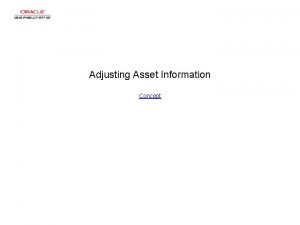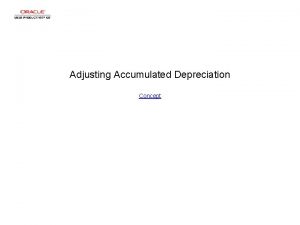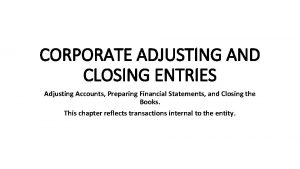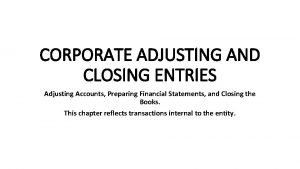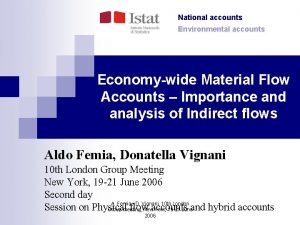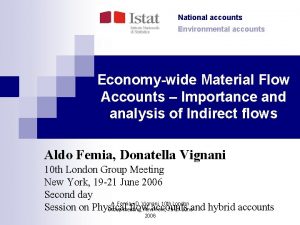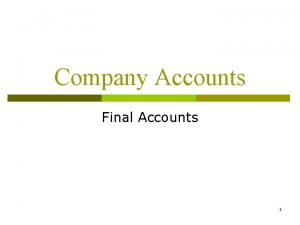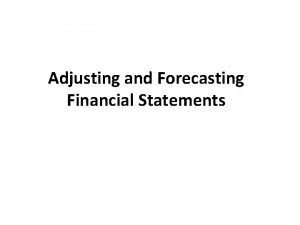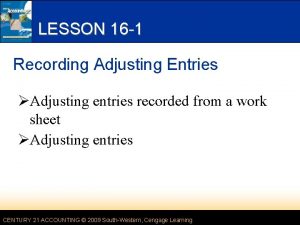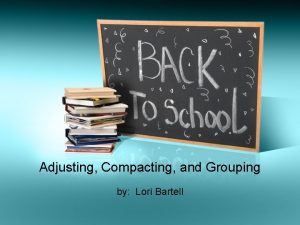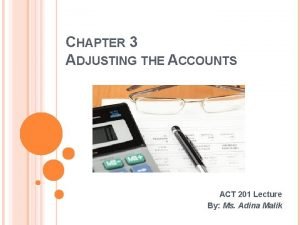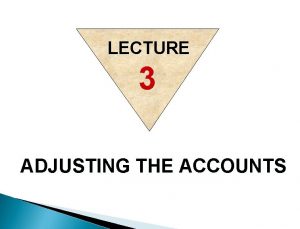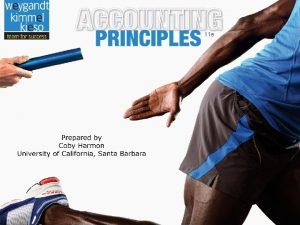Lecture 8 Adjusting the Accounts 1 Lecture 8








































































- Slides: 72

Lecture #8: Adjusting the Accounts 1

Lecture #8: Adjusting the Accounts 2

Lecture #8: Adjusting the Accounts 3

LECTURE # 7 SUMMARY Lecture #8: Adjusting the Accounts 4

SUMMARY OF THE LECTURE # 7 § That the company is a going concern. § That revenue should be recognized in the accounting period in which it is earned. § In accrual accounting, revenues and expenses are recorded when they are earned or incurred Lecture #8: Adjusting the Accounts 5

Completion of the Accounting Cycle Lecture #8: Adjusting the Accounts 6

LECTURE 8 COMPLETION OF THE ACCOUNTING CYCLE Lecture #8: Adjusting the Accounts 7

The Adjustment Process § Accrual accounting involves adjusting the accounts. – Adjustments are necessary because the accounting period, by definition, ends on a particular day. Some transactions invariably span the cutoff point, and therefore, some accounts need adjustment. Lecture #8: Adjusting the Accounts 8

The Nature of Adjusting Entries Ø A transaction affects the revenue or expense of two or more different periods. Ø In these cases, adjusting entries are needed to assign to each period the appropriate amounts of revenue and expenses. Ø These entries “adjust” the balance of various ledger accounts. Lecture #8: Adjusting the Accounts 9

The Adjustment Process – When transactions span more than one accounting period, accrual accounting requires the use of adjusting entries. These are either deferrals or accruals. § A deferral is the postponement of the recognition of an expense already paid or of revenue received in advance. Lecture #8: Adjusting the Accounts 10

The Adjustment Process – The cash payment or receipt is recorded before the adjusting entry is made. § An accrual is the recognition of an expense or a revenue that has arisen but not been recorded during the accounting period. The cash payment or receipt occurs in a future accounting period. Lecture #8: Adjusting the Accounts 11

Type 1 Adjustment: Allocating Recorded Costs (Deferred Expenses) § Companies often make expenditures that benefit more than one period. – These costs are debited to an asset account. Lecture #8: Adjusting the Accounts 12

Type 1 Adjustment: Allocating Recorded Costs (Deferred Expenses) – At the end of the accounting period, the amount of the asset that has been used is transferred from the asset account to an expense account. § Prepaid expenses are costs that companies pay in advance, such as rent, supplies, and insurance. Lecture #8: Adjusting the Accounts 13

Depreciation of Plant and Equipment • When a company buys a long-term asset, it is paying for the usefulness of that asset for as long as it benefits the company. • The accountant must allocate the cost of the asset over its estimated useful life. The amount allocated to any one accounting period is called depreciation. Lecture #8: Adjusting the Accounts 14

Depreciation of Plant and Equipment – To maintain historical costs, Accumulated Depreciation accounts are used to accumulate the depreciation on each long-term asset. Lecture #8: Adjusting the Accounts 15

Depreciation of Plant and Equipment • These accounts are called contra accounts. The balance of a contra account is shown on a financial statement as a deduction from its related account (for example, an asset account). • The net amount is called the carrying value (or book value) of the asset. Lecture #8: Adjusting the Accounts 16

Type 2 Adjustment: Recognizing Unrecorded Expenses (Accrued Expenses) • At the end of an accounting period, some expenses incurred during the period have not been recorded. These expenses require adjusting entries. Lecture #8: Adjusting the Accounts 17

Type 2 Adjustment: Recognizing Unrecorded Expenses (Accrued Expenses) • Examples include: – Interest on borrowed money – Wages – Utilities • These expenses are called accrued expenses because, as the expense and the corresponding liability accumulate, they are said to accrue. Lecture #8: Adjusting the Accounts 18

Type 3 Adjustment: Allocating Recorded, Unearned Revenues (Deferred Revenues) § When a company receives revenues in advance, it has an obligation to deliver goods or perform services. These unearned revenues are shown in a liability account. Lecture #8: Adjusting the Accounts 19

Type 3 Adjustment: Allocating Recorded, Unearned Revenues (Deferred Revenues) – As a company delivers part of the goods or performs part of the services, it earns a part of the advance receipts. – The earned portion must be transferred from the liability account to a revenue account. Lecture #8: Adjusting the Accounts 20

Type 4 Adjustment: Recognizing Unrecorded, Earned Revenues (Accrued Revenues) § Accrued revenues are revenues that a company has earned by performing a service or delivering goods but for which no entry has been made in the accounting records. – Any revenues earned but not recorded during an accounting period require an adjusting entry that debits an asset account and credits a revenue account. Lecture #8: Adjusting the Accounts 21

Using the Adjusted Trial Balance to Prepare Financial Statements § After adjusting entries have been recorded and posted, an adjusted trial balance is prepared by listing all accounts and their balances. – The revenue and expense accounts are used to prepare the income statement, and the asset and liability accounts are used to prepare the balance sheet. Lecture #8: Adjusting the Accounts 22

Using the Adjusted Trial Balance to Prepare Financial Statements – Net income from the income statement is combined with the Withdrawals account on the statement of owner’s equity to give the net change in the Capital account. – The balance of the Capital account is used in preparing the balance sheet. Lecture #8: Adjusting the Accounts 23

Discuss the role of accounting records in an organization? • Accounting records provide the information that is summarized in financial statements, income tax returns, and other accounting reports. In addition, these records are used by the company’s management and employees for such purposes as: 1. Establishing accountability for assets and transactions 2. Keeping track of routine business activities. Lecture #8: Adjusting the Accounts 24

Discuss the role of accounting records in an organization? 3. Obtaining details about specific transactions. 4. Evaluating the performance of units within the business. 5. Maintaining a documentary record of the business activities. (Such a record is required by tax laws and is useful for many business purposes, including audit. ) Lecture #8: Adjusting the Accounts 25

Basic Concepts of Journalizing Accounting Record: Journal: A chronological records of transactions, showing for each transaction the debits and credits to be entered in specific ledger accounts. The simplest type of journal is called a general journal. Account: A record used to summarize all increases and decreases in a particular asset, such as Cash, or any other type of asset. , liability, owner’s equity, revenue, or expense. Lecture #8: Adjusting the Accounts 26

Basic Concepts of Journalizing Accounting Record: Ledger: An accounting system includes separate record for each item that appears in the financial statements. Collectively, these records are referred to as company’s ledger. Individually, these records are often referred to as ledger accounts. Credit: An amount entered on the right hand side of a ledger account. A credit is used to record a decrease in an asset or an increase in a liability or in owner’s equity. Lecture #8: Adjusting the Accounts 27

Basic Concepts of Journalizing Accounting Record: Debit: An amount entered on the left hand side of a ledger account. A debit is used to record an increase in an asset or a decrease in a liability or in owner’s equity. Posting: The process of transferring information from the journal to individual accounts in the ledger. Lecture #8: Adjusting the Accounts 28

. Basic Concepts of Journalizing Accounting Record: Accounting Period: The span of time covered by an income statement. One year is the accounting period for much financial reporting, but financial statements are also prepared by companies for each quarter of the year and for each month. Fiscal Year: Any 12 - month accounting period adopted by a business. Lecture #8: Adjusting the Accounts 29

. Basic Concepts of Journalizing Accounting Record: Adjusting Entries: Entries required at the end of the period to update the accounts before financial statements are prepared. Adjusting entries serve to apportion transactions properly between the accounting periods effected and to record any revenue earned or expenses incurred that have not been recorded prior to the end of the period. Closing Entries: Journal entries made at the end of the period for the purpose of closing temporary accounts (revenue, expense, and owner’s drawing accounts) and transferring balances to the owner’s capital account. 30 Lecture #8: Adjusting the Accounts

. Basic Concepts of Journalizing Accounting Record: Trial Balance: A two-column schedule listing the names and the debit or credit balances of all accounts in the ledger. After Closing Trial Balance: A trial balance prepared after all closing entries have been made. Consists only of accounts for assets, liabilities, and owner’s equity. Lecture #8: Adjusting the Accounts 31

. Basic Concepts of Journalizing Accounting Record: Double Entry Accounting : A system of recording every business transaction with equal dollar amounts of both debit and credit entries. As a result of this system, the accounting equation always remains in balance. The system makes possible the measurement of net income and also the use of error-detecting devices such as trial balance. Revenue : The price of goods and services rendered by a business. 32 Lecture #8: Adjusting the Accounts

. Basic Concepts of Journalizing Accounting Record: Expenses : The cost of the goods and services used up in the process of obtaining revenue. Net income: An increase in owners’ equity resulting from profitable operations. Also, the excess of revenue earned over the related expenses for a given period. Net Loss: A decrease in owner’s equity resulting from unprofitable operations. 33 Lecture #8: Adjusting the Accounts

. Depreciation: The systematic allocation of the cost of an asset to expense during the periods of its useful life. Depreciable Assets: Physical objects with a limited life. The cost of these assets is gradually (periodically) recognized as depreciation expense. Lecture #8: Adjusting the Accounts 34

. Depreciation Useful Life: The period of time that a depreciable asset is expected to be useful to the business. This is the period over which the cost of the asset is allocated to depreciation expense. The widely used approach of recognizing an equal amount of depreciation expense in each period of a depreciable asset’s useful life. Lecture #8: Adjusting the Accounts 35

Rules of debit and credit for balance sheet accounts: ØIncreases in assets are recorded by debits and decreases are recorded by credits. Increases in liabilities and in owner’s equity are recorded by credits and decreases are recorded by debits. ØThe debit and credit rules are related to an account’s location in the balance sheet, . Lecture #8: Adjusting the Accounts 36

Rules of debit and credit for balance sheet accounts: ØIf the account appears on the left-hand side of the balance sheet (asset accounts), increases in the account balance are recorded by left-side entries (debit). ØIf the account appears on the right-hand side of the balance sheet (liability and owner’s equity accounts), increases are recorded by right-side entries (credit). Lecture #8: Adjusting the Accounts 37

Trial Balance: A two-column schedule listing the names and the debit or credit balances of all accounts in the ledger. In a trial balance, separate debit and credit columns are used to list the balances of the individual ledger accounts. The two columns are then totaled to prove the equality of the debit and credit balances. Lecture #8: Adjusting the Accounts 38

Trial Balance: Uses : This process provides assurance that ; 1. The total of the debits posted to the ledger was equal to the total of the credits and, 2. The balances of the individual ledger accounts were correctly computed. Lecture #8: Adjusting the Accounts 39

Trial Balance: Limitations: While a trial balance proves the equality of debit and credit entries in the ledger, it does not detect such errors as failure to record a business transaction, improper analysis of the accounts affected by the transaction, or the posting of debit or credit entries to the wrong accounts. Lecture #8: Adjusting the Accounts 40

Closing Entries and Their Purposes: Closing Entries: Journal entries made at the end of the period for the purpose of closing temporary accounts (revenue, expense, and owner’s drawing accounts) and transferring balances to the owner’s capital account. 41 Lecture #8: Adjusting the Accounts

Closing Entries and Their Purposes: Closing entries serve two basic purposes. I. To return the balance of the temporary owner’s equity accounts (revenue, expenses, and drawing accounts) to zero so that these accounts may be used to measure the activities of the next accounting period. II. To update the balance of the owner’s capital account. 42 Lecture #8: Adjusting the Accounts

Closing Entries and Their Purposes: III. Income Summary : The summary account in the ledger to which revenue and expenses accounts are closed at the end of the period. The balance (credit balance for a net income, debit balance for a net loss) is transferred to the owner’s capital account. 43 Lecture #8: Adjusting the Accounts

Closing Entries and Their Purposes: Four closing entries are generally needed: 1. Close the revenue accounts into the Income Summary account. 2. Close the expense accounts into the Income Summary account, 3. Close the balance of the Income Summary account ( representing net income or net loss) into the owner’s capital account, and 4. Close the drawing account into the owner’s capital account. 44 Lecture #8: Adjusting the Accounts

ILLUSTRATION 8. 1 • Louis Dixon, a dentist, resigned from his position with a larger dental group in order to begin his own pediatric dental practice. The practice was organized as a sole proprietorship, called Louis Dixon Pediatric Dentistry. The business transactions during September while the new venture was being organized are listed below; 1. Sept. 1 Dixon opened a bank account in the name of the business by depositing $50, 000 cash, which he had saved over a number of years. Lecture #8: Adjusting the Accounts 45

ILLUSTRATION 8. 1 2. Sept. 10 Purchased a small office building located on a large lot for a total price of $182, 400, of which $106, 000 was applicable to the land $76, 400 to the building. A cash payment of $36, 500 was made and a note payable was issued for the balance of the purchase price. 3. Sept. 15 Purchased a microcomputer system from Computer Stores, Inc, for $4, 680 cash. 4. Sept. 19 Purchased office furnishings, including dental equipment, from Turnkey Operations, Inc. , at a cost of $5, 760. A cash down payment of $960 was made, the balance to be paid in three equal installments due September 28, October 28 and November 28. The purchase was on open account and did not require signing of a promissory note. 46 Lecture #8: Adjusting the Accounts

ILLUSTRATION 8. 1 5. Sept. 26 A $140 monitor in the microcomputer system purchased on September 15 stopped working. The monitor was returned to Computer Stores, Inc. , which promised to refund the $140 within five days. 6. Sept. 28 Paid Turnkey Operations, Inc. , $1, 600 cash as the first installment due on the account payable for office furnishings. 7. Sept. 30 Received $140 cash from Computer Stores, Inc. , in full settlement of the account receivable created on September 26. Lecture #8: Adjusting the Accounts 47

ILLUSTRATION 8. 1 Instructions v. Prepare journal entries to record the above transactions. Select the appropriate account titles from the following chart of accounts: Cash Office Furnishings Accounts Receivables or (A/C R/A) Notes Payables or ( Note P/A) Land Accounts Payables (A/C P/A) Building Louis Dixon, Capital Computer System Lecture #8: Adjusting the Accounts 48

Dixon Pediatric Dentistry General Journal September 30, 200 -- Solution 8. 1 1. Date Accounts Titles & Explanations Sept. 01 Cash Debit Credit 5, 000 To Louis Dixon, Capital 5, 000 Owner Invested cash in the business 2. Sept. 10 Land 106, 000 Building 76, 400 To Cash 36, 500 To Note P/A 145, 900 Purchased Land Building for Cash and Note Payable. Lecture #8: Adjusting the Accounts 49

Dixon Pediatric Dentistry General Journal September 30, 200 -- Solution 8. 1 3. Date Accounts Titles & Explanations Sept. 15 Computer System Debit Credit 4, 680 To Cash 4, 680 To record purchase of Computer System for Cash 4. Sept. 19 Office Furnishings To Cash 5, 760 960 To Accounts P/A 4, 800 Purchased furnishings for Cash and Accounts Payable. Lecture #8: Adjusting the Accounts 50

Dixon Pediatric Dentistry General Journal September 30, 200 -- Solution 8. 1 5. Date Accounts Titles & Explanations Sept. 26 A/C R/A Debit Credit 140 To Computer System 140 To record return a computer system on Accounts Receivable 6. Sept. 26 Accounts P/A 1, 600 To Cash 1, 600 Paid cash as installment for Office Furnishings Lecture #8: Adjusting the Accounts 51

Dixon Pediatric Dentistry General Journal September 30, 200 -- Solution 8. 1 7. Date Accounts Titles & Explanations Sept. 30 Cash A/C Debit Credit 140 To A/C R/A 140 Received Cash against Accounts receivables TOTAL Lecture #8: Adjusting the Accounts 199, 720 52

ILLUSTRATION 8. 2 Lars Retton is the founder and owner of North Coast Gymnastics, a youth gymnastics training facility. A few of the company’s business transactions occurring during July are described below: 1. On July 02, collected cash of $700 from accounts receivable. 2. On July 07, purchased gymnastics equipment for $2, 175, paying $500 in cash and charging the remainder on the company’s 30 -day account at Weider Fitness Co. 3. On July 09, returned to Weider Fitness Co. $200 of gymnastics equipment that was not needed. The return of this equipment reduced by $200 the amount owed to Weider Fitness Co. Lecture #8: Adjusting the Accounts 53

ILLUSTRATION 8. 2 4. On July 25, Retton made an additional investment in North Coast Gymnastics by depositing $5, 000 cash in the company bank account. 5. On July 31, paid the remaining $1, 475 owed to Weider Fitness Co. Instruction: v Prepare journal entries, including explanations, for the above transactions Lecture #8: Adjusting the Accounts 54

North Coast Gymnastics General Journal July 31, 200 -- Solution 8. 2 1. Date Accounts Titles & Explanations July 02 Cash A/C Debit Credit 700 To Accounts R/A 700 Collected Cash from Accounts Receivable. 2. July 07 GYM Equipments A/C 2, 175 To Cash 500 To Account P/A 1, 675 Purchased Gymnastics Equipment for Cash and Account Payable. Lecture #8: Adjusting the Accounts 55

North Coast Gymnastics General Journal July 31, 200 -- Solution 8. 2 3. Date Accounts Titles & Explanations July 09 Accounts R/A Debit Credit 200 To GYM Equipments A/C 200 Returned GYM Equipment on Account Receivableble. 4. July 25 Cash A/C 5, 000 To Lars Retton, Capital A/c 5, 000 Lars Retton incvested additional Cash in the venture. Lecture #8: Adjusting the Accounts 56

North Coast Gymnastics General Journal July 31, 200 -- Solution 8. 2 5. Date Accounts Titles & Explanations July 31 Account P/A Debit Credit 1, 475 To Cash A/C 1, 475 Paid for accounts payable Accounts. . TOTAL Lecture #8: Adjusting the Accounts 9, 550 57

ILLUSTRATION 8. 3 City Flights provides transportation by helicopter between a major airport and various business centers of a large city. Amoung the ledger accounts used by the company are the following: Cash Passenger Fare Revenue Notes Payables or ( Note P/A) Advertising Expense Aircraft Fuel Expense Accounts Receivables or (A/C R/A) Rent Expense O. Wright , Capital Repair & maintenance Expense O. Wright , Drawing Salary Expense Lecture #8: Adjusting the Accounts 58

ILLUSTRATION 8. 3 Some of the January transactions of City Flight are listed below: 1. Jan. 03 Paid $3, 520 rent for hanger space during January. 2. Jan. 04 Placed advertizing in local newspaper for publication during January. The agreed price of $860 was payable within 10 days after the end of the month. 3. Jan. 15 Cash receipt from passengers for the first half of January amounted to $23, 160. Lecture #8: Adjusting the Accounts 59

ILLUSTRATION 8. 3 4. Jan. 15 O. Wright, the owner, withdrew $7, 500 cash for personal use. 5. Jan. 16 Paid salaries to employees for services rendered in first half of January, $13, 200. 6. Jan. 25 Provided transportation for executives of the Hurley Corporation, a long time credit customer. Sent bill for $470 due within 30 days. Lecture #8: Adjusting the Accounts 60

ILLUSTRATION 8. 3 7. Jan. 29 Received a bill from Western Oil Co. for fuel used in January, amounting to $4, 340 and payable by February 10. 8. Jan. 31 Paid $3, 372 to Stevens Motors for repair and maintenance work during January. Instructions: v Prepare a journal entry (including an explanation) for each of the above transactions. Lecture #8: Adjusting the Accounts 61

CITY FLIGHTS General Journal January 31, 200 -- Solution 8. 3 1. Date Accounts Titles & Explanations Jan. 03 Rent Expense Debit Credit 3, 520 To Cash R/A 3, 520 Paid Rent in Cash. 2. Jan. 04 Advertisement Exp. A/C To Account P/A 860 Advertisement Expense Payable in 10 days. Lecture #8: Adjusting the Accounts 62

CITY FLIGHTS General Journal January 31, 200 -- Solution 8. 3 3. Date Accounts Titles & Explanations Jan. 15 Cash A/C Debit Credit 23, 160 To Passenger Fare Revenue A/C 23, 160 Received Cash for Passenger Fare for the Ist half of Jan. 4. Jan. 15 O. Wright , Drawing A/C To Cash A/C 7, 500 The owner withdraws Cash for personal use. Lecture #8: Adjusting the Accounts 63

CITY FLIGHTS General Journal January 31, 200 -- Solution 8. 3 5. Date Accounts Titles & Explanations Jan. 16 Salaries Expense A/C Debit Credit 13, 200 To Cash A/C 13, 200 Paid Salaries for the Month of (M/O) Jan. 6. Jan. 25 Accounts Receivables A/C To Notes Payables A/C 470 Sent bill for services to be paid in 30 days. Lecture #8: Adjusting the Accounts 64

CITY FLIGHTS General Journal January 31, 200 -- Solution 8. 3 7. Date Accounts Titles & Explanations Jan. 29 Fuel Expense A/C Debit Credit 4, 340 To Notes Payables A/C 4, 340 Received bill for Fuel expense for the M/O Jan. 8. Jan. 31 Repair & maintenance Expense A/C 3, 372 To Cash A/C 3, 372 Paid Cash for the repair and maintenance during January. TOTAL Lecture #8: Adjusting the Accounts 56, 422 65

LECTURE # 8 SUMMARY Lecture #8: Adjusting the Accounts 66

SUMMARY Lect # 8 § Liquidity measures ability to pay short-term obligations when they come due. § 1 Debit each revenue account for its balance, and credit the owner’s capital account for total revenues. § 2 Debit the owner’s capital account for total expenses, and credit each expense account for its balance. Lecture #8: Adjusting the Accounts 67

SUMMARY Lect # 8 § Errors that occur in recording transactions should be corrected as soon as they are discovered by preparing correcting entries. § A work sheet is a multiple-column form that may be used in the adjustment process and in preparing financial statements. § A reversing entry is made at the beginning of the next accounting period. Lecture #8: Adjusting the Accounts 68

SUMMARY Lect # 8 § The debit and credit rules for recording revenue and expenses are based on the rules for recording changes in owner’s equity. § Earning revenue increases owner’s equity: therefore, revenues are recorded with credit entries. § Expenses reduces owner’s equity and are recorded with debit entries. Lecture #8: Adjusting the Accounts 69

Lecture #8: Adjusting the Accounts 70

Lecture #8: Adjusting the Accounts 71

Lecture #8: Adjusting the Accounts 72
 The updating of accounts is called the adjusting process.
The updating of accounts is called the adjusting process. The time period assumption states that
The time period assumption states that Chapter 3 adjusting accounts for financial statements
Chapter 3 adjusting accounts for financial statements Adjusting the accounts
Adjusting the accounts Adjusting the accounts chapter 3 solutions
Adjusting the accounts chapter 3 solutions Adjusting the accounts chapter 3
Adjusting the accounts chapter 3 Fees earned debit or credit
Fees earned debit or credit Adjusting the accounts chapter 3
Adjusting the accounts chapter 3 Adjusting the accounts chapter 3
Adjusting the accounts chapter 3 Accrued expenses entry
Accrued expenses entry 01:640:244 lecture notes - lecture 15: plat, idah, farad
01:640:244 lecture notes - lecture 15: plat, idah, farad Adjusting entries are natural opposites
Adjusting entries are natural opposites Journal entry for accrued revenue
Journal entry for accrued revenue Accrued revenue adjusting entry
Accrued revenue adjusting entry Journalize adjusting entries
Journalize adjusting entries Closing entries
Closing entries Fungsi fuel system
Fungsi fuel system Why is evaluating and adjusting a spending plan important
Why is evaluating and adjusting a spending plan important Adjusting recipes worksheet answers
Adjusting recipes worksheet answers Chemical equation chart
Chemical equation chart Adjusting entries for depreciation
Adjusting entries for depreciation Adjusting process
Adjusting process Advertising expense adjusting journal entry
Advertising expense adjusting journal entry Merchandising income statement
Merchandising income statement Reactants
Reactants Journalizing adjusting entries
Journalizing adjusting entries Four closing journal entries
Four closing journal entries Method of adjusting isotonicity
Method of adjusting isotonicity Adjusting entries affect the cash account
Adjusting entries affect the cash account Adjusting entries for merchandise inventory
Adjusting entries for merchandise inventory What's the scp for adjusting a pi ilium?
What's the scp for adjusting a pi ilium? Adjusting entries
Adjusting entries Journalizing and posting adjusting and closing entries
Journalizing and posting adjusting and closing entries Adjusting a recipe
Adjusting a recipe Balancing an equation involves adjusting
Balancing an equation involves adjusting Balance sheet accrued expenses
Balance sheet accrued expenses Century 21 south western accounting answer key
Century 21 south western accounting answer key The adjusting process
The adjusting process 12 column worksheet accounting example
12 column worksheet accounting example Definition of adjusting entries
Definition of adjusting entries White vincent method formula
White vincent method formula Adjusting entries merchandise inventory
Adjusting entries merchandise inventory Journalizing adjusting entries
Journalizing adjusting entries Umut acar cmu
Umut acar cmu Interest expense adjusting entry
Interest expense adjusting entry Contoh adjusting entries
Contoh adjusting entries Balancing an equation involves adjusting
Balancing an equation involves adjusting Adjusted trial balance
Adjusted trial balance 8-1 8-2 application problems
8-1 8-2 application problems Valve adjusting wrench berfungsi
Valve adjusting wrench berfungsi Vẽ hình chiếu vuông góc của vật thể sau
Vẽ hình chiếu vuông góc của vật thể sau Làm thế nào để 102-1=99
Làm thế nào để 102-1=99 Tỉ lệ cơ thể trẻ em
Tỉ lệ cơ thể trẻ em Lời thề hippocrates
Lời thề hippocrates đại từ thay thế
đại từ thay thế Vẽ hình chiếu đứng bằng cạnh của vật thể
Vẽ hình chiếu đứng bằng cạnh của vật thể Quá trình desamine hóa có thể tạo ra
Quá trình desamine hóa có thể tạo ra Các môn thể thao bắt đầu bằng tiếng chạy
Các môn thể thao bắt đầu bằng tiếng chạy Công thức tiính động năng
Công thức tiính động năng Thế nào là mạng điện lắp đặt kiểu nổi
Thế nào là mạng điện lắp đặt kiểu nổi Hình ảnh bộ gõ cơ thể búng tay
Hình ảnh bộ gõ cơ thể búng tay Khi nào hổ mẹ dạy hổ con săn mồi
Khi nào hổ mẹ dạy hổ con săn mồi Dạng đột biến một nhiễm là
Dạng đột biến một nhiễm là Nguyên nhân của sự mỏi cơ sinh 8
Nguyên nhân của sự mỏi cơ sinh 8 độ dài liên kết
độ dài liên kết Voi kéo gỗ như thế nào
Voi kéo gỗ như thế nào Thiếu nhi thế giới liên hoan
Thiếu nhi thế giới liên hoan điện thế nghỉ
điện thế nghỉ Một số thể thơ truyền thống
Một số thể thơ truyền thống Trời xanh đây là của chúng ta thể thơ
Trời xanh đây là của chúng ta thể thơ Thế nào là hệ số cao nhất
Thế nào là hệ số cao nhất Hệ hô hấp
Hệ hô hấp
